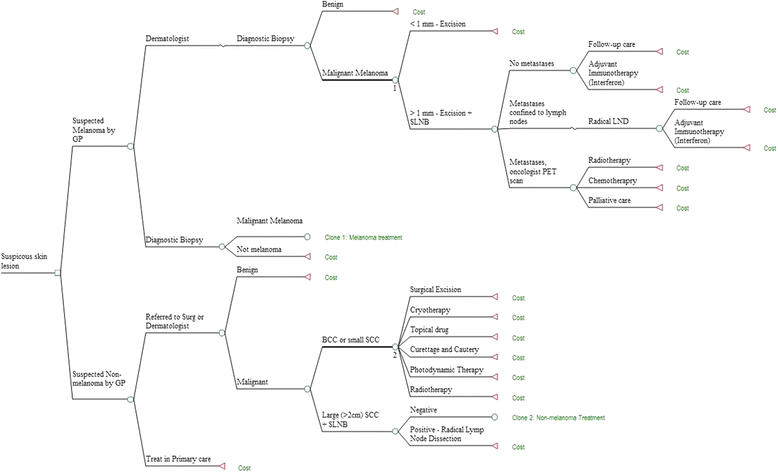Modelling the healthcare costs of skin cancer in South Africa
- PMID: 27039098
- PMCID: PMC4818961
- DOI: 10.1186/s12913-016-1364-z
Modelling the healthcare costs of skin cancer in South Africa
Abstract
Background: Skin cancer is a growing public health problem in South Africa due to its high ambient ultraviolet radiation environment. The purpose of this study was to estimate the annual health system costs of cutaneous melanoma, squamous cell carcinoma (SCC) and basal cell carcinoma (BCC) in South Africa, incorporating both the public and private sectors.
Methods: A cost-of-illness study was used to measure the economic burden of skin cancer and a 'bottom-up' micro-costing approach. Clinicians provided data on the patterns of care and treatments while national costing reports and clinician fees provided cost estimates. The mean costs per melanoma and per SCC/BCC were extrapolated to estimate national costs using published incidence data and official population statistics. One-way and probabilistic sensitivity analyses were undertaken to address the uncertainty of the parameters used in the model.
Results: The estimated total annual cost of treating skin cancers in South Africa were ZAR 92.4 million (2015) (or US$15.7 million). Sensitivity analyses showed that the total costs could vary between ZAR 89.7 to 94.6 million (US$15.2 to $16.1 million) when melanoma-related variables were changed and between ZAR 78.4 to 113.5 million ($13.3 to $19.3 million) when non-melanoma-related variables were changed. The primary drivers of overall costs were the cost of excisions, follow-up care, radical lymph node dissection, cryotherapy and radiation therapy.
Conclusion: The cost of managing skin cancer in South Africa is sizable. Since skin cancer is largely preventable through improvements to sun-protection awareness and skin cancer prevention programs, this study highlights these healthcare resources could be used for other pressing public health problems in South Africa.
Keywords: Basal cell carcinoma; Cost-of-illness; Melanoma; Skin cancer; Squamous cell carcinoma.
Figures
Similar articles
-
Estimating the economic costs of skin cancer in New South Wales, Australia.BMC Public Health. 2015 Sep 23;15:952. doi: 10.1186/s12889-015-2267-3. BMC Public Health. 2015. PMID: 26400024 Free PMC article.
-
The economic burden of occupational non-melanoma skin cancer due to solar radiation.J Occup Environ Hyg. 2018 Jun;15(6):481-491. doi: 10.1080/15459624.2018.1447118. Epub 2018 Apr 25. J Occup Environ Hyg. 2018. PMID: 29695213
-
Benefit Cost Analysis of Three Skin Cancer Public Education Mass-Media Campaigns Implemented in New South Wales, Australia.PLoS One. 2016 Jan 29;11(1):e0147665. doi: 10.1371/journal.pone.0147665. eCollection 2016. PLoS One. 2016. PMID: 26824695 Free PMC article.
-
Solar Ultraviolet Radiation, Skin Cancer and Photoprotective Strategies in South Africa†.Photochem Photobiol. 2023 Mar;99(2):509-518. doi: 10.1111/php.13676. Epub 2022 Jul 29. Photochem Photobiol. 2023. PMID: 35841370 Review.
-
Epidemiology and economic burden of nonmelanoma skin cancer.Facial Plast Surg Clin North Am. 2012 Nov;20(4):419-22. doi: 10.1016/j.fsc.2012.07.004. Facial Plast Surg Clin North Am. 2012. PMID: 23084294 Review.
Cited by
-
Skin cancer risk factors among Black South Africans-The Johannesburg Cancer Study, 1995-2016.Immun Inflamm Dis. 2022 Jul;10(7):e623. doi: 10.1002/iid3.623. Immun Inflamm Dis. 2022. PMID: 35759242 Free PMC article.
-
Identification of an ergosterol derivative with anti-melanoma effect from the sponge-derived fungus Pestalotiopsis sp. XWS03F09.Front Microbiol. 2022 Oct 12;13:1008053. doi: 10.3389/fmicb.2022.1008053. eCollection 2022. Front Microbiol. 2022. PMID: 36312981 Free PMC article.
-
Global, regional and national incidence, mortality and disability-adjusted life-years of skin cancers and trend analysis from 1990 to 2019: An analysis of the Global Burden of Disease Study 2019.Cancer Med. 2021 Jul;10(14):4905-4922. doi: 10.1002/cam4.4046. Epub 2021 Jun 9. Cancer Med. 2021. PMID: 34105887 Free PMC article.
-
Classification of skin cancer stages using a AHP fuzzy technique within the context of big data healthcare.J Cancer Res Clin Oncol. 2023 Sep;149(11):8743-8757. doi: 10.1007/s00432-023-04815-x. Epub 2023 May 2. J Cancer Res Clin Oncol. 2023. PMID: 37127829 Free PMC article.
-
Squamous Cell Carcinoma: A Clinical and Histopathological Review of a South African Tertiary Dermatology Unit.J Skin Cancer. 2025 Jun 20;2025:8884436. doi: 10.1155/jskc/8884436. eCollection 2025. J Skin Cancer. 2025. PMID: 40584143 Free PMC article.
References
-
- Melanoma Fact Sheet [http://www.melanoma.co.za/D_doccnr_MFS.asp]. Accessed 24 Feb 2015.
-
- Africa SS. Mid-year population estimates. In: Africa SS; 2014.
-
- Stein L, Urban MI, O’Connell D, Yu XQ, Beral V, Newton R, Ruff P, Donde B, Hale M, Patel M, et al. The spectrum of human immunodeficiency virus-associated cancers in a South African black population: results from a case-control study, 1995–2004. Int J Cancer. 2008;122(10):2260–5. - PubMed
Publication types
MeSH terms
LinkOut - more resources
Full Text Sources
Other Literature Sources
Medical
Research Materials




